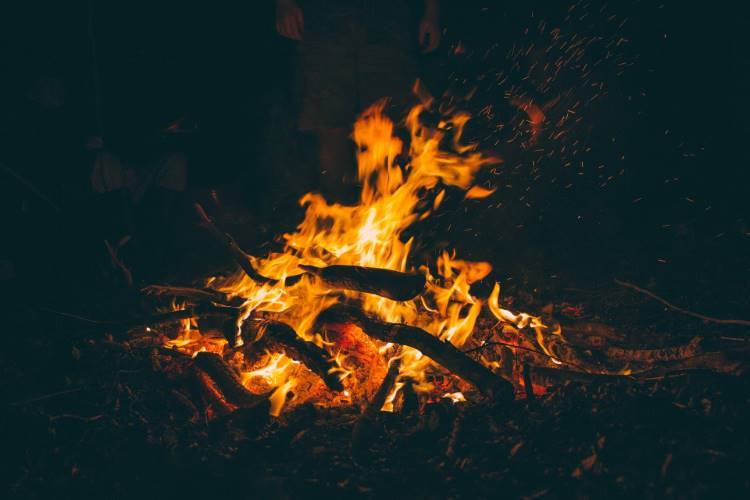Wet weather can make camping really miserable. Trying to get a fire going when everything is wet can be one of the most frustrating things while camping, especially if you don’t have much experience in this situation.
Can you put a tarp over a fire? A tarp can put over a small fire to protect it from the rain, although care needs to be given to prevent the tarp from catching on fire and causing major safety concerns.
Putting a tarp over a fire isn’t actually all that complicated. It just requires a few precautions and common sense.
In this post I’ll give you some tips on how to do it safely.
Note: Don’t start a forest fire. If there’s a fire warning in the area that you’re camping, LISTEN TO IT. Always ensure that your campfire area is a safe distance away from anything flammable.
What Kind of Tarp to Use Over a Fire
You generally don’t need any special kind of tarp for use over a fire, as long as it’s actually a tarp. A regular poly tarp can be used as long as it’s set up properly.
HOWEVER, a canvas tarp is by nature more fire-resistant. Canvas can still burn, but it won’t light up like a torch and it won’t melt (unlike poly tarps). They don’t carry a flame like plastic will.
The downside to canvas is that it’s a bit more expensive and it’s definitely heavier than a regular plastic tarp.
Personally, I like to use canvas because it’s super durable and I just don’t have to worry about tearing it or burning it like I do with a poly tarp. In my opinion (for what it’s worth) a canvas tarp is safer to use around a fire.
They’re not ridiculously expensive, though, and they do last a really long time. You can find a great canvas tarp for use around a fire here on Amazon. For what it costs, it’s a really worthwhile investment for anyone that likes the outdoors.
So a canvas tarp isn’t NECESSARY, but it’s definitely a good idea if you’re not too concerned about a bit of extra weight.
Note: NEVER use a rain fly from a tent. They’re made from nylon and will burn through at any hint of a spark. They’re not safe to use for this purpose and you’ll totally trash it. Avoid anything made from nylon.
To be fair, polyethylene is flammable too. The problem with nylon camping gear and flammability is that nylon is generally paper thin and has zero resistance to sparks.
Will the Fire Burn Through the Tarp?
It depends on the size of the fire and how close the tarp is to it.
Obviously, you can’t have a massive bonfire. But a smaller size of a fire for 2-3 people isn’t really a problem.
Some people are worried about sparks burning holes in the tarp, but I’ve never had a major problem with it. This is especially true if you’re using a canvas tarp.
Even still, I generally avoid using a tarp around especially sparky fires, and I’m cautious about stirring the coals, which can give off extra heat and sparks.
But if you have a good setup and are using a good tarp, it will probably last for years until it’s too damaged to be useful.
How to Set Up a Tarp Over a Fire
First off, make sure that your tarp is far enough away from trees and other flammable things. I like to use a healthy amount of paracord to give a reasonable safe zone to my fire and tarp.
For smaller fires, around 16″ in diameter or less, a tarp that’s hung up around 6′ off the ground generally works perfectly well.
There are a lot of different ways to set up a tarp over a fire, and everyone has an opinion about it.
Here’s how I do it:
I use basically an A-frame kind of setup, with one main variation.
Instead of a horizontal line for the top of the tarp, I slant it at a fairly noticeable angle. Maybe something along the lines of 20 degrees or so.
I set the tarp up so that the high end is roughly 6′ off the ground.
Then I start the fire at the higher end.
The reason that I like this way of setting up a tarp over a fire is that it helps to direct the smoke outside of the tarp. It just really sucks if the smoke can’t get out fast enough and gets in your face.
It’s simple and fast to set up, and this style gives you great coverage from the rain. It’s really dry and toasty once the fire gets going.
You’ll need to use a bit of common sense for how high to let your fire go. I generally try to keep the flame at around 16″ or lower from the ground.
I think that one of the reasons that the tarp doesn’t burn is that the heat can escape easily enough, and the cool air from the back side helps prevent the tarp from burning. It surprisingly don’t get all that hot.
If it’s raining, the water on the top side really does a great job of cooling the tarp and further helps to keep it from catching on fire.
Other Tips
To make sure that the tarp isn’t overheating, check the temperature of the tarp with your hand from time to time. It will definitely feel warm, but it shouldn’t be too hot to touch.
If you’re wanting to get more heat from your fire to help you dry off, try using a heat reflector. You can build one yourself out of bush materials or bring a mylar sheet to keep it quick and easy.

